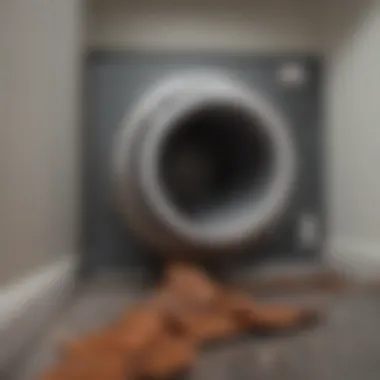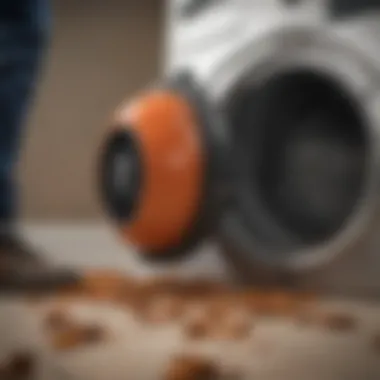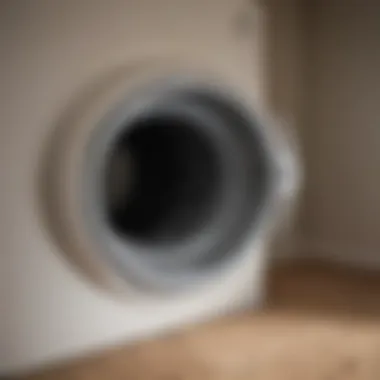Mastering Dryer Vent Cleaning with a Leaf Blower


Intro
Cleaning your dryer vent is not just a mundane chore, it is essential for safety and efficiency in your home. A clogged vent can lead to longer drying times, elevated energy bills, and even pose a fire hazard. Using a leaf blower is an effective method to tackle this task, providing a way to remove lint and debris from the vent system with relative ease.
In this article, we will delve into the importance of regular dryer vent maintenance. Additionally, we will outline the tools needed, emphasizing the leaf blower’s role in simplifying the process. You will also find a detailed step-by-step guide, safety measures to keep in mind, and the potential challenges you might encounter along the way.
Let’s explore the various aspects of cleaning your dryer vent, ensuring that your vent remains clear and your dryer operates at peak performance.
Prelude to Dryer Vent Cleaning
Cleaning your dryer vent is an essential task that often goes unnoticed until it's too late. This activity holds significant importance in maintaining not just the efficiency of your dryer but also the safety of your home. A clean dryer vent ensures that the appliance operates optimally and prevents potential hazards associated with lint build-up, which can lead to fires.
The Importance of Clean Dryer Vents
Clean dryer vents enhance energy efficiency. When lint accumulates, airflow is restricted, causing the dryer to work harder. This additional strain can lead to increased energy consumption and higher utility bills over time. By routinely cleaning the vents, you improve airflow and reduce the energy needed for drying clothes.
Furthermore, clean dryer vents prolong the lifespan of the appliance. Less lint in the system means fewer mechanical issues. Homeowners often overlook the cost of repairs caused by neglected maintenance. Regular cleaning is a proactive step towards minimizing repair expenses and ensuring longevity.
The prevention of fire is another vital reason for keeping dryer vents clean. According to the National Fire Protection Association, failure to clean dryer vents is one of the leading causes of home laundry fires. Lint is highly flammable, and when it accumulates, it creates an environment suitable for fires to ignite. Hence, making vent cleaning a priority is not just about efficiency but also about safety.
Consequences of Neglecting Vent Maintenance
Ignoring the maintenance of dryer vents can lead to several negative consequences. Firstly, the most immediate impact is reduced performance. Users might notice that clothes take longer to dry or are still damp after the cycle. This inefficiency not only frustrates users but also results in unnecessary wear and tear on the machine.
Another severe consequence is the heightened risk of fire hazards. Lint blockage may cause the dryer to overheat, which could lead to an electrical failure and potential fires. The physical toll on the appliance is often not apparent until serious damage occurs. Homeowners might face costly repairs or a complete replacement.
Additionally, neglecting vent maintenance can foster unpleasant odors in the laundry area. Build-up of lint and moisture creates a breeding ground for mold and mildew, leading to health concerns for occupants. It can also make the home less inviting and contribute to decreased property value.
Understanding Dryer Vents
Understanding dryer vents is crucial for any homeowner. Many may not realize that these systems play a significant role in household safety and efficiency. The dryer vent transports heated air and lint generated by the dryer to the outside of the home. Maintaining this system is fundamental to preventing fire hazards and ensuring that the dryer functions correctly. When dryer vents become clogged, the airflow diminishes, leading to overheating and potential damage to the dryer.
How Dryer Vents Work
Dryer vents work by channeling warm, moist air from the dryer to the exterior of the house. The dryer expels air through a system of ducts. Usually, these ducts are semi-rigid or flexible aluminum. The flow of air through the dryer vent helps to remove moisture and lint that accumulates during the drying cycle. A properly functioning vent allows the dryer to operate efficiently, which can help to reduce energy costs while improving the drying process.
The system contains a vent cap outside where air exits, usually with a flap that only opens when air is passing through. This flap prevents the entry of pests and debris into the vent. However, if the vent becomes blocked, hot air may remain within the dryer, causing the drum to run hotter than intended. As a result, this can lead to overheating and a potential fire risk. Keeping the vent free from lint build-up is essential for both safety and efficiency.
Common Types of Dryer Vents
- Metal Ducts: These are the most common and preferred type for dryer vent systems due to their durability and fire resistance. They come in semi-rigid or rigid forms and offer better airflow and easier cleaning potential.
- Flexible Ducts: These are easier to install but less recommended for long runs. They can trap lint more easily, making them harder to clean and more prone to fire hazards.
- Plastic or Vinyl Ducts: These are generally not recommended for dryer venting because they are more flammable than metal and can easily collapse.
In summary, understanding how dryer vents operate and the types available informs homeowners about effective maintenance practices. By ensuring that the vent system is clean and functional, the benefits are significant. Proper airflow not only enhances dryer efficiency but also mitigates risks related to wear and tear on appliances and fire hazards.
Tools Required for Cleaning


Cleaning your dryer vent with a leaf blower requires specific tools to ensure an effective process. The right tools make the task easier and safer, leading to a more thorough job. Selecting the right tools allows for proper maintenance of your dryer vent, reducing the risks associated with lint build-up and improving the efficiency of your dryer. Poor ventilation can lead to a range of problems including fire hazards and increased energy costs. Therefore, understanding the tools necessary for this task is crucial.
Essential Tools for the Task
To begin with, having the essential tools on hand is fundamental. The tools you will require include:
- Leaf blower: A powerful leaf blower helps clear debris and lint from the vent. This is the primary tool for the task.
- Extension wand: Useful for reaching into long ducts, this attachment helps direct the air flow deeper into the ventilation system.
- Vacuum cleaner with hose attachment: Though the leaf blower does the heavy lifting, a vacuum can help capture loose lint effectively.
- Screwdriver set: You may need to unscrew vent covers or the dryer itself. Make sure to have both flathead and Phillips screwdrivers.
- Safety goggles and gloves: Protect your eyes and hands from dust and debris.
Having these tools ready will set you up for a successful cleaning exercise. This preparation step minimizes delays during the actual cleaning process and ensures safety by reducing risks of accidents.
Choosing the Right Leaf Blower
Not all leaf blowers are created equal when it comes to cleaning dryer vents. There are several considerations when choosing which leaf blower to use. First, look for a blower with adequate power. A model with at least 200 CFM (cubic feet per minute) is recommended for effective lint removal.
Next, consider the size and weight of the leaf blower. A lightweight model allows for easier maneuverability, especially in tight spaces around your dryer. It is also wise to select a blower that offers different speed settings; this gives you the ability to adjust the airflow depending on how much debris you are dealing with.
In addition, think about the power source. Leaf blowers can be gas-powered or battery-operated. Gas models often provide more power but they can be heavier and louder. On the other hand, battery-operated blowers are quieter and more convenient but may have less power. Depending on your needs, choose the one that fits your situation best.
Ultimately, selecting the right leaf blower enhances the effectiveness of your cleaning, ensuring you have the best tool to keep your dryer vent clear and safe.
Preparing for the Cleaning Process
Preparing for cleaning the dryer vent is an essential step that sets the foundation for a successful and safe experience. Proper preparation creates an environment where the cleaning process can be executed efficiently and with minimal risk of injury or damage. It involves understanding the risks, gathering necessary tools, and ensuring the work area is ready.
Safety Precautions to Consider
Safety should always be prioritized when performing any home maintenance tasks, including cleaning dryer vents. Here are some crucial safety precautions to consider:
- Unplug Your Dryer: Before beginning, ensure that the dryer is unplugged. This step prevents any accidental starts during the cleaning process.
- Wear Protective Gear: Use gloves to protect your hands from sharp edges and dust. A mask can help shield you from inhaling lint and debris.
- Ventilation: Make sure the area is well-ventilated. Dust and lint can create a fine material in the air, which might irritate your respiratory system.
- Use the Right Ladder: If accessing the vent requires a ladder, ensure it is stable and positioned correctly. Never overreach while using a ladder.
- Keep Tools Nearby: Having your tools close can avoid unnecessary movement or distraction while working, which can lead to accidents.
Gathering Your Tools
Having the right tools is vital for an effective cleaning process. Ensure you gather all necessary items before starting. Here’s a list of tools you will likely need:
- Leaf Blower: Select a powerful leaf blower, preferably with multiple speed settings. This will allow for effective removal of lint and debris.
- Flathead Screwdriver: Useful for loosening and removing any screws that may be securing the vent cover.
- Extension Ladder: Required for reaching the vent if it is located high up on the exterior of your home.
- Vacuum with Brush Attachment: While the leaf blower is the primary tool, having a vacuum handy can assist in collecting loose lint that may not be blown away.
- Safety Goggles and Gloves: Protect your eyes and hands from dust and debris that can arise during the cleaning process.
With the preparations detailed above, you are set to proceed with cleaning your dryer vent more confidently and effectively.
Step-by-Step Guide to Cleaning the Dryer Vent
Cleaning your dryer vent is vital for maintaining appliance efficiency and safety. A clogged vent can lead to lengthy drying times, increased energy bills, and even fire hazards. In this section, we will break down the step-by-step process for cleaning your dryer vent using a leaf blower. This practical approach provides clear instructions, ensuring that homeowners and enthusiasts can undertake this task with confidence.
Disconnecting the Dryer
The first step in this cleaning process involves disconnecting your dryer from the power source. Ensuring safety is paramount in this task. Begin by unplugging the dryer from its electrical outlet. This action eliminates any risk of shock while working. If your dryer is hardwired, turn off the breaker that supplies power to it. Next, gently pull the dryer away from the wall. This will give you access to the vent connecting the dryer to the exterior exhaust. Remember to be cautious during this process, as the dryer can be heavy.


Accessing the Ventilation System
With your dryer safely disconnected, the next task is to access the ventilation system. Locate the vent that is connected to the back of the dryer. Depending on the model, you might find it attached with clamps or screws. Use a screwdriver or pliers to loosen or remove these fasteners.
Once the vent is detached, you can also inspect the duct for any visible lint buildup. It is crucial to keep the access point clear to allow for effective cleaning. After ensuring the tunnel is clear, proceed to the next step. Having proper access will allow the leaf blower to effectively remove debris that may have accumulated over time.
Utilizing the Leaf Blower
Now comes the primary cleaning stage, utilizing the leaf blower. Position the blower at the opening of the vent. Ensure that the nozzle is inserted into the vent as far as it can go without damaging it. Turn the leaf blower on, selecting a high power setting if available. The force from the blower will expel the accumulated lint and debris down the tube and out of the other end.
This method can be more efficient than manual cleaning alone, as it helps to dislodge stubborn debris. Continue blowing air through the vent for several minutes to ensure all lint is removed. It may be useful to periodically check the exterior exhaust to see if lint is being expelled, indicating that the cleaning is effective.
Reassembling the Dryer
With the vent cleaned, it is time to reassemble everything. Carefully attach the vent back to the dryer, securing it with screws or clamps. Ensure that there are no loose connections to avoid future debris buildup. After everything is fastened, push your dryer back against the wall and plug it into the power source once again.
Complete a final check to confirm that the vent has no obstructions and the dryer is functioning securely. It is recommended to run a short drying cycle to test if the airflow is adequate. Pay attention to any unusual noises or signs of inefficient drying, as these may indicate further issues that need addressing.
Post-Cleaning Considerations
After the cleaning process, there are several important aspects to consider to ensure that the dryer vent is in optimal condition. Post-cleaning considerations help verify that the job was done correctly and that the dryer is functioning efficiently. Ignoring these steps can lead to potential issues down the line, which could negate the benefits of the thorough cleaning.
Inspecting for Damage
Once the dryer vent has been cleaned, it's essential to inspect the system for any signs of damage. This should include checking the vent itself, the connections to the dryer, and surrounding areas. Some common issues to look for are:
- Cracks or breaks in the vent pipes.
- Loose connections that may allow lint to escape.
- Signs of wear on the hose or ducting.
If you notice any damage during the inspection, address it immediately. Minor issues can often be repaired easily, while major damage may necessitate replacement parts.
Testing Dryer Functionality
After the inspection, it is important to test the functionality of your dryer to assure it is operating correctly. Here’s what you can do:
- Reconnect Your Dryer: Ensure that all connections are secure.
- Run a Cycle: Start a drying cycle with a small load of laundry. Keep an ear out for any unusual noises that may indicate a problem.
- Monitor Vent Airflow: Stand by the vent exit located outside your home. You should feel steady airflow. If the airflow seems restricted or weak, there may still be lint blocking the system.
- Check for Odors: A burning smell or any unusual odors could indicate that the dryer is not functioning properly, which requires further investigation.
Testing the dryer not only assures functionality but also confirms that the cleaning was effective. If any issues arise during the test, do not hesitate to reassess your cleaning efforts or consult a professional.
When to Seek Professional Help
Cleaning a dryer vent is essential for maintaining optimal dryer performance and ensuring safety in your home. However, there are times when attempting a DIY clean may not be sufficient. Recognizing these instances is critical. It fundamentally influences the effectiveness of the maintenance performed and the long-term safety of your appliance.
Identifying When Cleaning is Insufficient
There are various signs that indicate a simple cleaning may not resolve the issue. If you notice that your dryer is taking longer than usual to dry clothes, this may point to deeper obstruction within the vent. Additionally, if clothes are excessively hot to the touch after a cycle, this indicates a potential fire hazard or a blockage.


Another indicator is the presence of a musty smell, which can occur when moisture gets trapped in the vent. If lint keeps appearing in your lint trap despite regular cleaning, it suggests that lint is accumulating deeper in the ventilation system. These scenarios often warrant professional assessment. Attempting to tackle these issues without proper knowledge or tools can lead to ineffective cleaning or even damage to your dryer.
Finding a Qualified Service Provider
When the decision to seek professional help is made, selecting the right service provider is crucial. Look for technicians who specialize in dryer vent cleaning and have positive reviews. Recommendations from friends or online forums can provide insights into reliable professionals in your area.
Verify their qualifications and experience. It's essential that they are licensed and insured. This protects you from any liabilities should accidents happen during the cleaning process.
Once you have a shortlist, ask about their cleaning process. Ensure they use specialized tools and techniques applicable to your type of system. It’s also beneficial to inquire about their service guarantees. A provider who stands by their work can offer you peace of mind.
By understanding when to seek professional help and how to find the right service provider, you ensure that your dryer vent remains in excellent condition. This ultimately contributes to a safer home environment and prolongs the life of your dryer.
Maintaining a Clean Dryer Vent
Cleaning the dryer vent is not a one-time task. It is essential for homeowners to develop good habits regarding maintenance. Regularly maintaining a clean dryer vent ensures efficiency and safety. Clogged vents can lead to longer drying times, which waste energy. Furthermore, lint buildup is a fire hazard, making maintenance vital for both economy and safety.
Establishing a Regular Cleaning Schedule
Creating a regular cleaning schedule is key. Homeowners should identify how often their dryer vent needs attention. Depending on usage, a cleaning every six months to a year might suffice. For households with heavy dryer use or pets, more frequent cleaning may be necessary.
- Set reminders: Use a calendar application to set reminders for vent cleaning. This ensures it remains a priority.
- Keep notes: Track when cleaning occurs. This provides insight into how often the vent becomes cluttered.
- Include other tasks: Combine dryer vent cleaning with other household chores, making it part of an overall maintenance routine.
By establishing a schedule, the risk of neglect decreases greatly.
Signs that Indicate a Need for Cleaning
Identifying signs that your dryer vent needs cleaning can help prevent issues. There are clear indicators to watch for:
- Long drying times: If clothes take longer than normal to dry, the vent may be blocked.
- Excess lint: Noticing lint around the dryer or inside the vent opening is a clear sign the vent needs attention.
- Heat buildup: If the dryer exterior feels unusually hot during use, it could indicate restricted airflow.
- Burning smell: Any smell of burning is serious. It means lint is overheating and poses a fire hazard.
Pay close attention to these signs. Catching problems early can save time and prevent dangerous situations.
In summary, maintaining a clean dryer vent requires establishing a regular schedule and being observant of signs indicating cleaning is needed. It is crucial for efficient operation and safety.
Ending
When it comes to the upkeep of your home, ensuring that your dryer vent is clean is often overlooked. In this guide, we have not only examined the process of cleaning a dryer vent using a leaf blower but also highlighted the critical importance of regular maintenance. This conclusion ties together all the vital elements discussed earlier, reinforcing their significance in maintaining a safe and efficient drying system.
Summary of Key Points
First, it is essential to stress the importance of clean dryer vents. Blockages can lead to various problems, including decreased dryer efficiency and even fire hazards.
- Understanding Dryer Vents: A good knowledge of how dryer vents work and their types can help in recognizing maintenance needs.
- Regular Cleaning Schedule: Setting a regular cleaning schedule can prevent lint buildup, making your dryer work better.
- Safety First: When performing any maintenance, prioritizing safety through proper precautions is crucial.
- Professional Help: Knowing when to seek professional assistance ensures that any issues beyond a simple cleaning are addressed effectively.
Highlighting these points serves to remind you that taking care of your dryer vent is less a chore and more of a necessity.
The Long-Term Benefits of Proper Vent Maintenance
The long-term benefits of keeping your dryer vent clean extend far beyond immediate safety. Maintaining a clear vent leads to energy efficiency, which can have financial benefits. When the dryer works efficiently, it consumes less energy, which lowers utility bills.
Moreover, consistent maintenance extends the life of your dryer. A dryer that operates under optimal conditions is less likely to fail prematurely. You will find that an efficient dryer results in less frequent repair needs, saving you both time and money.
Furthermore, a clean vent can improve air quality within your home. Lint buildup can harbor dust and allergens, potentially aggravating respiratory issues. By keeping the vent clear, you contribute to a healthier living environment for yourself and your family.



